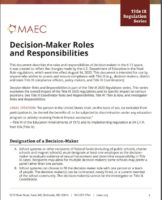
Download: Title-IX-Decision-Maker
This document describes the roles and responsibilities of Decision-Makers in the K-12 space. It was created to reflect the changes made by the U.S. Department of Education in the Final Rule regulations, which went into effect August 14, 2020. This document is intended for use by anyone who wishes to assess and ensure compliance with Title IX (e.g., Decision-Makers, district and state Title IX compliance officers, policy makers, and Title IX Coordinators).
Decision-Maker Roles and Responsibilities is part of the Title IX 2020 Regulations series. This series examines the overall impact of the Title IX 2020 regulations and its specific impact on various positions. See other documents in the series:
- Title IX Coordinator Roles and Responsibilities,
- Title IX Then and Now for K-12 – What has Changed?,
- Title IX Investigator Roles and Responsibilities,
- and Title IX Grievance Procedure.
Decision-Maker Roles and Responsibilities
LEGAL CITATION: “No person in the United States shall, on the basis of sex, be excluded from participation in, be denied the benefits of, or be subjected to discrimination under any education program or activity receiving Federal finance assistance.”
—Title IX of the Education Amendments of 1972 and its implementing regulation at 34 C.F.R. Part 106 (Title IX)
Core Responsibilities of the Decision-Maker
The Title IX regulations of 2020 created the position of Decision-Maker to separate the determination of guilt or innocence from the investigative process. The Decision-Maker is effectively the judge of Title IX cases: They preside over hearings, if applicable, and issue the verdict in the form of written determinations. Decision-Makers monitor the questioning and cross-examination process and identify irrelevant questions. At the end of the process, they weigh the evidence to determine if it meets the school’s standard of sexual harassment allegations. Decision-Makers produce a written statement to both parties describing their verdict.
Like judges, Decision-Makers cannot have a conflict of interest or bias for or against any member in the proceedings. The Title IX Coordinator should vet Decision-Makers prior to their designation in this role.
Mandatory Training
School districts need to ensure that they train the Decision-Maker, Investigator, and Title IX Coordinator in preparation for their roles in the Title IX grievance procedure. This training must include the following:
- the definition of sexual harassment
- the scope of the school’s education program or activity
- how to conduct an investigation and grievance process (including hearings, appeals, and informal resolution processes)
- how to serve impartially (including by avoiding prejudgment of the facts at issue, conflicts of interest, and bias)
The Decision-Maker needs to receive two additional pieces of training:
- any technology to be used at a live hearing
- issues addressing relevance of questions and evidence during the live hearing
Grievance Procedures: Questioning Process
Decision-Makers must allow each party to ask relevant and follow-up questions to the other party and any witnesses. If the parties choose to have a hearing; cross-examination must be done directly, orally, and in real time by the party’s advisor. The parties do not need to be in the same room, but all must have technology that enables the Decision-Maker(s) and parties to see and hear the party or witness answering questions. If the parties do not have a hearing, Decision-Makers must allow each party the opportunity to question other parties and witnesses. Parties can submit written, relevant questions: The Decision-Maker will share the answers, and parties are allowed to ask follow-up questions. If the Decision-Maker identifies a question as “irrelevant,” they must explain their reasoning. Should any party or witness not
participate in cross-examination during a live hearing, the Decision-Maker cannot use any part of their testimony in reaching final determination regarding responsibility. The hearing and/or questioning should be conducted within a “reasonably prompt” time frame.
Written Determination
Decision-Makers must share their written determination with both parties simultaneously. The written determination must include the six following components:
- identification of the sexual harassment allegations
- a description of the grievance procedure steps taken
- findings and evidence that support the determination
- conclusions regarding the application of the recipient’s code of conduct to the facts
- a statement of and rationale for the results for each allegation, including:
- determining responsibility: if the respondent’s alleged actions broke school policy
- for the respondent: any disciplinary sanctions that the school imposes
- for the complainant: any remedies (provided by the school) designed to restore or preserve equal access to the school’s education program or activity
- permissible grounds for appeal, as well the school’s appeal procedures
Appeals Process
If one or both of the parties appeals the determination, the school must use a different Decision-Maker to preside over the appeal process. The Decision-Maker will offer both parties the opportunity to submit a written statement explaining why they support or challenge the
determination. After reading their statements and reviewing the evidence and findings from the grievance procedure, the appeals Decision-Maker will issue a written determination, which they will provide to both parties simultaneously.
Adapted from the U.S. Department of Education Title IX Final Rule regulations.

